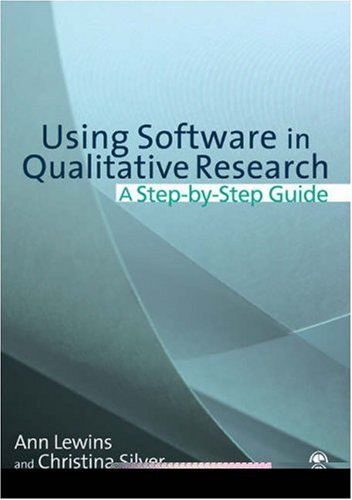Using Software in Qualitative Research: a Step-By-Step Guide
Lewins, Ann and Silver, Christina
Sage Publications, London
2007
ISBN 9780761949237 (paperback)
Order this book?
 'Using Software in Qualitative Research: A Step-by-Step Guide' is a useful and user friendly guide to Computer Assisted Qualitative Data AnalysiS (CAQDAS) software packages. This book is ideal for anyone who (like myself) is a beginner researcher and not very familiar with using software packages for analysing textual data. It could also be used by more advanced researchers with specific research questions and problems in mind. The volume provides a step-by-step guide to the tasks and processes involved in doing qualitative research with software packages. It focuses specifically on three different CAQDAS programmes: ATLAS.ti5, MAXqda2 and NVivo7.
'Using Software in Qualitative Research: A Step-by-Step Guide' is a useful and user friendly guide to Computer Assisted Qualitative Data AnalysiS (CAQDAS) software packages. This book is ideal for anyone who (like myself) is a beginner researcher and not very familiar with using software packages for analysing textual data. It could also be used by more advanced researchers with specific research questions and problems in mind. The volume provides a step-by-step guide to the tasks and processes involved in doing qualitative research with software packages. It focuses specifically on three different CAQDAS programmes: ATLAS.ti5, MAXqda2 and NVivo7.
The volume compromises 13 chapters following a task-based logic. Four appendixes at the back of the volume provide sections on research examples, practical advice on software and a general comparison between the three main software packages outlined in the book and other four CAQDAS packages. Each chapter is supplemented with illustrations in order to exemplify practical usage of the software's tools and applications. Icons are also used throughout the volume in order to indicate to the reader the nature and usefulness of specific tasks. Importantly, at the end of each chapter the authors provide a summary and a comparative comment on the three CAQDAS packages featured. Essentially, this book does not need to be read from beginning to end. Each chapter can be consulted and used as and when needed. For the less experienced researcher on the other hand, I found that the entire volume provides a logical and task-oriented approach to working with CAQDAS.
Chapter 1 compares the different aspects of CAQDAS programmes and introduces the general software capabilities and functions. As well as outlining differences and commonalities, this chapter provides a basic structure of processes and tasks available in CAQDAS software. Reading this chapter in conjunction with Appendix C (Features and Functions of Seven CAQDAS Packages) gives the reader a broad comparative framework for the evaluation of the different functionalities and tool of the leading software programmes. The rest of the book builds on Chapter 1 and covers key processes and practices involved in qualitative data analysis, from data preparation and management, coding schemes, to linking ideas and interrogating data.
Chapter 2 focuses on the different types of data and on the tools used to integrate them in the software. Practical exercises for data preparation with the three different CAQDAS software are provided and exemplified by clear visual aids and graphics depicting the various software screens. Chapter 3 familiarises the reader with the different software packages. Together with general exercises (creating codes, importing data and using mapping tools amongst others), this chapter allows the reader to learn more about the three specific CAQDAS software programmes.
Chapters 4 to 6 are concerned with text-level work (including 'annotation', 'hyperlinking' and 'note making'), with 'principles and processes' in coding textual data and, with 'coding schemes and coding structures'. These three chapters focus on how to prepare the data for the later process of data analysis and provide the researcher with a choice of 'strategies'.
Chapters 7 and 8 as well as 11 and 12 are more practically oriented. Chapter 7 for example provides instructions for basic coding in the three software packages, while chapter 8 focuses on the retrieval of coded data. This is a practical chapter that also illustrate how to generate reports on coded data. The aim here is to encourage the reader to continuously reflect on the coding process and the patterns, contradictions and relationships that emerge. Chapters 11 and 12 respectively, focus on the organisation of data and interrogation of the data. The remaining chapters (9, 10 and 13) focus on what the authors refer to as 'the bits in between' (p.3).
Chapter 9 highlights the importance of writing in qualitative research and discusses how to manage and maximise efficiently the variety of memo tools in the featured CAQDAS packages. Chapter 10 links the writing with the mapping processes including tasks on the integration and retrieval of data, coded relationships and layers or groups formation in the data. Here the authors suggest starting points for creating graphic maps and advice on how to visualise connections as well as guidance for integrating mapping tools with other aspect of the work. Finally, Chapter 13 provides a short summary regarding the authors' views on the use of software in qualitative research and on the implications of using CAQDAS for methodology.
This is a useful and practical handbook on how to best undertake qualitative research using CAQDAS packages. The book is truly user-friendly and rich in personal insights and advice making it a useful tool to the experienced and beginner researcher alike.
Ivano Bruno
University of Portsmouth |

